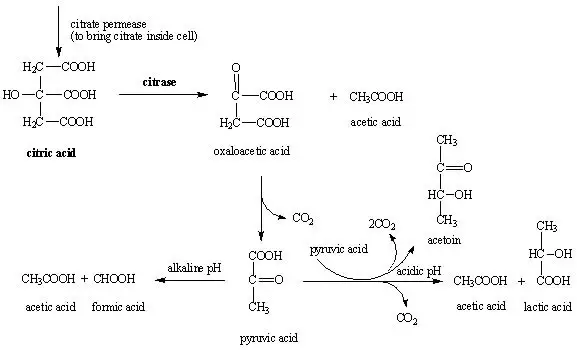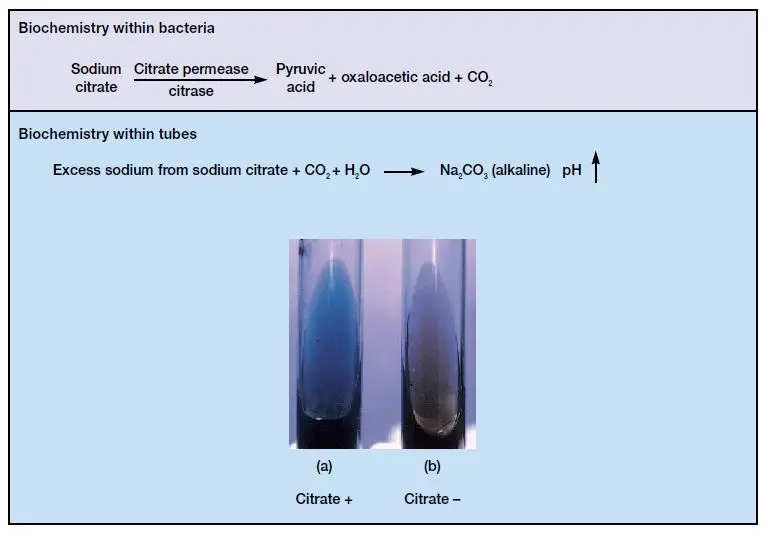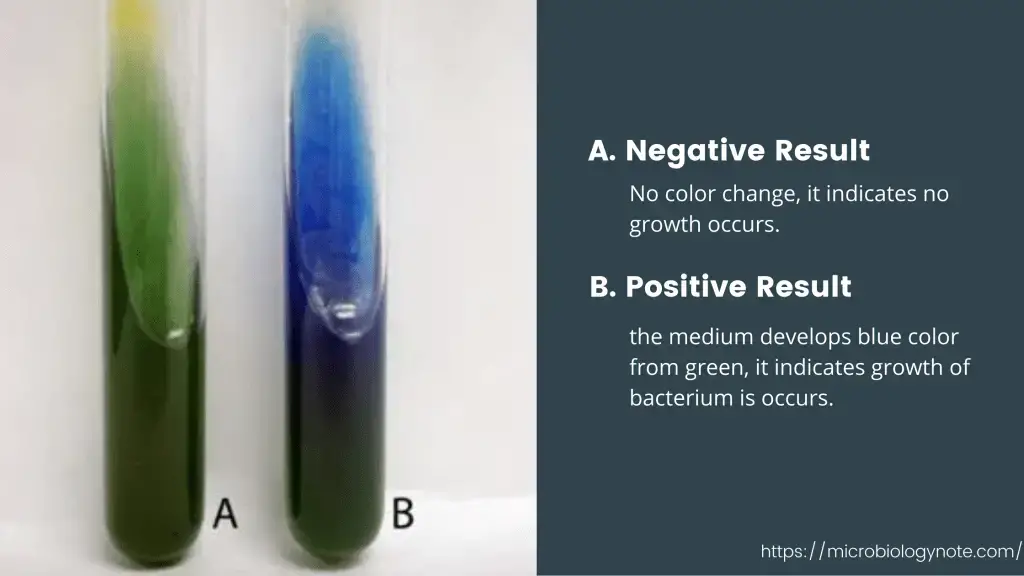Contents
About Simmons citrate agar test
Simmons citrate agar test helps in detection of citrate utilizing bacteria. In this test, a specific medium is used called Simmons’ citrate agar which helps to differentiate among various Gram-negative enteric bacilli.
Simmons’ citrate agar is a type of selective and differential medium. Which is used for the study of those organisms that have the ability to use citrate as a sole carbon source and ammonium ions as the sole nitrogen source.
This medium composed of citrate which is the main carbon source of the medium, and ammonium ions as the main source of Nitrogen, and also contains several inorganic ions. This media also contain a pH indicator bromothymol blue, which turns in green at pH below 6.9, and turms blue at pH above 7.6.
The citrate utilization ability of a bacteria depends on the presence of a citrate permease that helps in the transport of citrate into the bacterium. Once citrate enters into the bacterium, it’s started to converted into pyruvic acid and CO2.
Simmons citrate test performed in slants, because O2 is necessary for citrate utilization. In this method, if the test organism started to utilize the citrate for carbon and energy sources, it will grow on Simmons citrate agar. As a result, it will lead to a rise in pH of the medium, and a pH indicator changes color.
Objective of Simmons citrate agar test
The Simmons citrate test helps to identify those bacteria have the ability to utilize citrate as a main carbon source for their energy needs.
Principle of Citrate Utilization test

Simmons citrate test is used for the detection of carbon utilization bacteria from Simmons citrate agar. In this method, a test microorganism first inoculated with the Simmons citrate agar, which is composed of citrate, ammonium, few inorganic ion for growth, and a pH indicator such as bromothymol blue.
The utilization of citrate is occurred by the enzyme citrase. This citrase enzyme helps in breaks down of citrate into oxaloacetate and acetate. After that, oxaloacetate again break down into pyruvate and carbon dioxide (CO2).
On the other side, the bacteria started to breakdown the ammonium salts into ammonia, as a result, it increases the alkalinity of medium. This raises the pH, turns the pH indicator to a blue color, and represents a positive citrate test, absence of a color change is a negative citrate test.

Requirements
- Nutrient broth culture of test organisms (E. coli and Enterobacter aerogenes).
- Simmon’s citrate agar slants.
*Composition for 1000 ml Simmon’s citrate agar:
| Ingredients | Amounts |
|---|---|
| Ammonium dihydrogen phosphate | 1.0 g |
| dipotassium phosphate | 1.0 g |
| Sodium chloride | 5.0 g |
| Agar | 15.0 g |
| Bromothymol blue | 0.8 g |
| Sodium citrate | 2.0 g |
| Magnesium sulphate | 0.2 g |
| Distilled water | 1000 ml |
Simmons citrate agar test procedure
Preparation of Simmon’s Citrate Agar Slant:
- Dissolve all the ingraditens in water, except phosphates.
- Then dissolve phosphates separatly in 100ml distilled water, And adjust the volume of medium to 1000ml.
- Set the pH to 6.9.
- Pour the prepaed medium in sterile culture tubes and sterilize them using autoclave for 15 mins, and prepae the slants.
Citrate Utilization Test:
- Inoculate Simmons citrate agar on the slant by touching a colony that is 18-24 hrs old with a straight wire.There is no need to stab the butt of the medium. Do not inoculate from the broth culture because the inoculum will be too heavy.
- Incubate at 35oC-37oC for up to 7 days.
- Observe the blue coloration of the media.
Result of Simmons citrate test
- Positive Result: If the medium develops blue color from green, it indicates growth of bacterium is occurs.
- Negative Result: No color change, it indicates no growth occurs.

Uses of Simmons citrate test
This Simmons citrate test is used to identify gram-negative pathogens of Enterobacteriaceae family and environmental isolates. Also used as an instance test kits such as the API-20E and Enterotube II include citrate utilization medium as one of the diagnostic tests.
Conclusion
Enterobacter aerogenes is a citrate positive where color of the medium changes from Green to blue while E. coli is a citrate negative where the medium remains green.
Precautions
Always use a light inoculum to minimize carryover of nutrients from the medium to grow the inoculum on Simmon’s citrate agar slant this could be done by transferring cells from the slants to the distilled water.
List of Bacteria which gives positive and negative result in Simmons citrate test
| Microorganism | Result |
|---|---|
| Klebsiella pneumoniae | Positive (+) |
| Salmonella Typhi | Negative (-) |
| Enterobacter species | Positive (+) |
| Citrobacter freundii | Positive (+) |
| Escherichia coli | Negative (-) |
| Shigella spp | Negative (-) |
| Serratia marcescens | Positive (+) |
| Proteus mirabilis | Positive (+) |
| Salmonella Paratyphi A | Negative (-) |
| Providencia | Positive (+) |
| Morganella morganii | Negative (-) |
| Yersinia enterocolitica | Negative (-) |
| Salmonella other than Typhi and Paratyphi A | Positive (+) |












Thank you